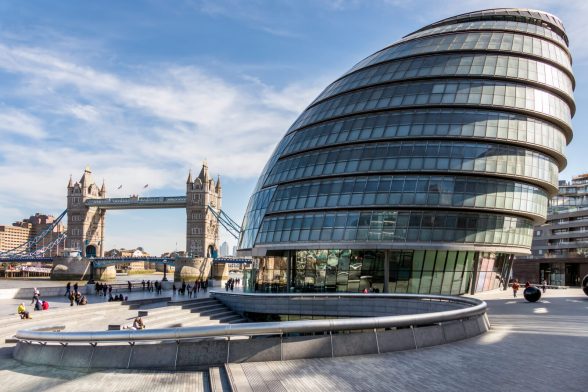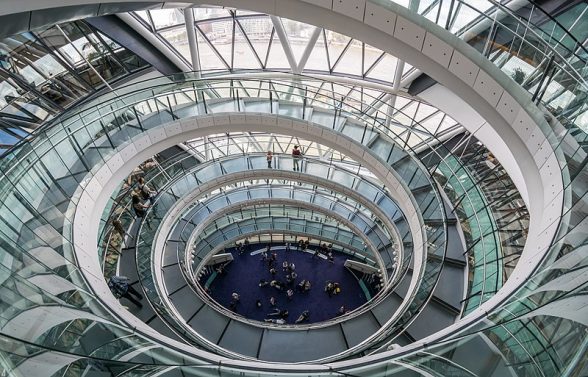This website uses cookies
This website uses cookies to enable it to function properly and to analyse how the website is used. Please click 'Close' to accept and continue using the website.



Image: Shutterstock
The Foster + Partners designed City Hall, until earlier this year the symbolic seat of London’s government, has just had a COI (Certificate of Immunity from Listing) request refused by the Secretary of State for Digital, Culture, Media and Sport, leaving open the possibility of a future listing.
City Hall was opened by the Queen in July 2002 as a home for the newly devolved Greater London Assembly (GLA). The design was strongly informed by Foster’s previous renovation and adaptation of the Berlin Reichstag (completed in 1999), with City Hall a similarly symbolic architectural embodiment of democratic values (transparency, accessibility, and openness), whilst the crystalline, geometric form was seen by some commentators as a forerunner to the even more ambitious London Swiss Re tower (‘the Gherkin’) which was built shortly after in 2001-03. Then Mayor of London Ken Livingstone notoriously referred to the building prior to opening as ‘a glass testicle’.
Its interior features a helical walkway which spirals up to the full height of the building and also houses an assembly chamber, committee rooms, offices for the Mayor, assembly members and support staff. A publicly accessible space at the highest point of the building known as ‘London’s Living Room’ was never fully opened as intended, ultimately becoming a private events space following a review of security in the wake of the September 11th 2001 terrorist attacks.

Image: Foster & Partners
Buildings at Risk list
In January 2014, the More London Estate – a 13-acre complex of 11 buildings, including City Hall – was sold for £1.7 billion to Kuwaiti-owned St Martins Property Group, in one of the UK’s largest ever property deals. The GLA had been leasing City Hall from its Kuwaiti landlords for £11 million a year, with the terms of the 25-year-old lease including a break in the contract at the end of 2021. The prospect of the GLA vacating the building prompted C20 Society to include City Hall in our annual ‘Buildings at Risk’ campaign and to submit a listing application, which was first rejected in March 2021, with a threat to the building not yet sufficiently clear.
Following a consultation with staff, assembly members and unions, the GLA duly triggered the break clause and relocated staff to WilkinsonEyre’s The Crystal building in Newham’s Royal Docks, a move the Mayor Sadiq Khan claimed would save taxpayers some £61 million over 5 years. Shortly after the building was vacated in January 2022, owners St Martins Property Group applied for a COI, which was strongly objected to by C20 Society. If granted, this would have given the building immunity from listing for 5 years, paving the way for significant alterations or even demolition.
C20 Society is pleased with DCMS’s rejection of the COI request, leaving the door open for the building to be considered again for listing in future. Indeed, while Historic England’s report concluded that it was still too soon to fully assess the architectural significance of City Hall, it pointedly did not rule out that the criteria for listing may be met in the future.

Image: Creative commons
A surprising development from the consultation was Foster + Partners response in support of a COI from listing, issuing the following statement:
‘Foster + Partners has always argued in favour of reuse and renewal of buildings, which can be given a new lease of life through sensitive interventions. By sympathetically adapting existing structures, we can enhance building performance and functionality, while reducing embodied carbon content. As architects of the original structure, we recognise the symbolic value of City Hall and have a strong sense of attachment to it. However, we believe the building should be allowed to have a new life and be repurposed and reused without being limited by its previous role as a governmental office. We believe this approach is the ultimate compliment recognising the value of a building, while simultaneously ensuring it is viable for future generations.’
C20 Society would stress that listing of the building would not prevent it from having a new use, with the ‘sympathetically adaptions’ and ‘sensitive interventions’ Foster + Partners reference still achievable within a building of significant architectural and heritage value.
Regional democracy made homeless
The fate of London’s former City Hall is one replicated across the country over the past decade, where numerous local authorities have been forced to leave or consider leaving their often purpose built headquarters, due to severe budget restrictions and cost cutting measures.
This invariably results in architecturally significant Civic Centres, Town Halls and City Halls being sold to private developers and put at risk of demolition, with our regional democracy often relegated to much diminished accommodation.
Other recent examples tackled by C20 Society include Shirehall in Shropshire, Sunderland Civic Centre and Swansea Civic Centre

Become a C20 member today and help save our modern design heritage.